With proper care and proper design, this tropical vine will decorate the house with lush greenery for many years. It is said that this plant absorbs the negative energy of skeptical people and brings the freshness of change. Caring for syngonium at home is described in the article - it is an amazingly vibrant and fast-growing creeping plant.
Material Content:
Syngonium: types and varieties
In nature, the greatest species diversity of syngonium is found in Costa Rica and Panama - about 16 species. In decorative floriculture, 2 varieties are popular - stalked and ear-shaped syngonium.
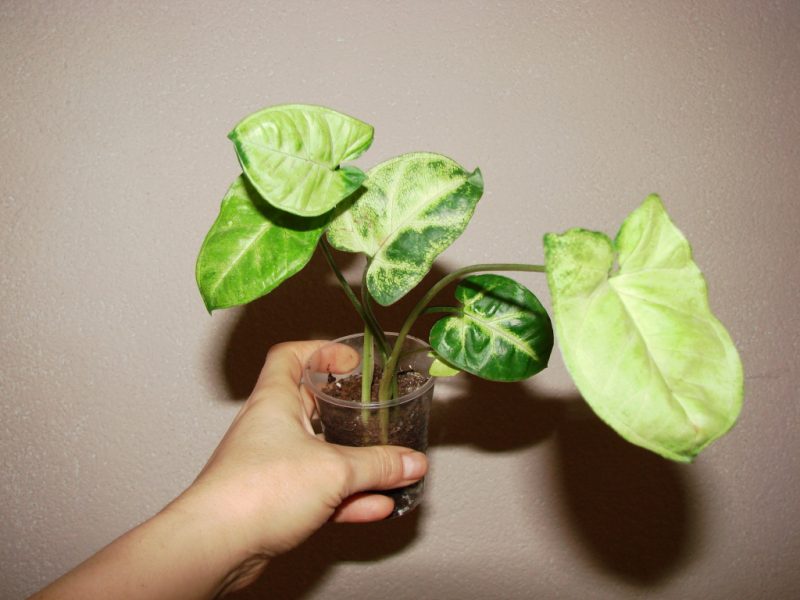
Breeders bred decorative varieties with beautiful coloring of leaves:
- “Pink” - young leaves are pinkish, turn pale with age, heart-shaped in shape, the lower side of the leaf plate is light green;
- "Pixie" - glossy light green foliage with light veins creates a characteristic motley color of the vine;
- "Panda" - a bushy variety with yellow stains on dark green leafy plates, growing rapidly;
- "Brokant" - brown leaves with greenish veins;
Liana blooms in the house very rarely. Flowers are inconspicuous, the green top cover of the inflorescences is painted inside in a bright color. The fruits of the syngonium legifolia are edible, they have a pleasant smell. With age, the shape of the leaves changes in the creeper - this distinguishes it from similar plants of the genus Aroid.
Basic requirements for growing
A flexible, long stalk of syngonium can be braided around a vertical support - you will get an attractive tall plant up to 2 meters high.So that the branches hang freely down, the pot is hung higher or placed on a cabinet. Lack of light will not be a problem - all types of syngonium do not like the bright sun. An exception is varieties with variegated leaves, which require good lighting to preserve color.
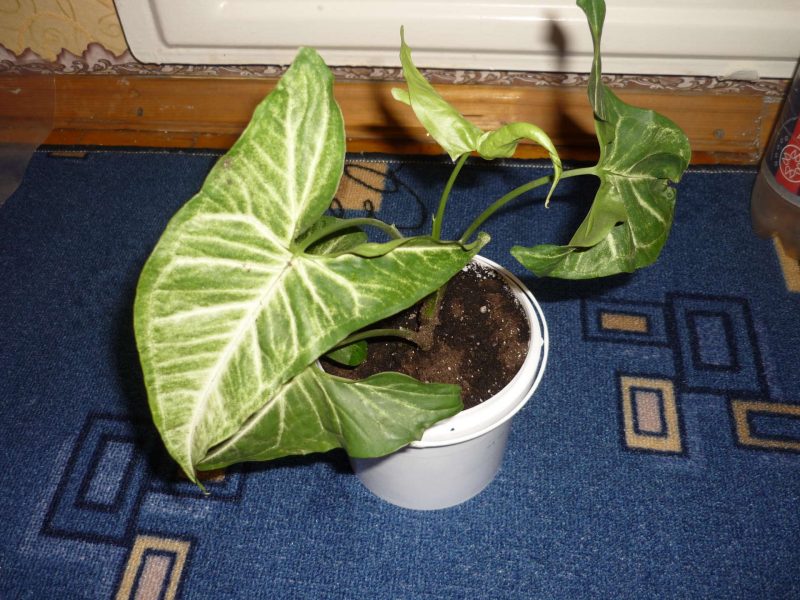
- The plant loves warm and humid air, its optimum temperature is about 20 ° C.
- Frequent spraying of foliage is helpful.
- In the spring, formative pruning of creepers is carried out.
- In winter, feeding is not necessary, and throughout the warm season, the syngonium is fertilized with complex fertilizers containing potassium, phosphorus and nitrogen in equal proportions.
Home Care
The plant does not require special care. Dust is washed off the leaves as they become dirty, and in addition to spraying with water, it is useful to wipe the leaf plates with a soft sponge. Maintaining high humidity is the main condition for successful flower cultivation.
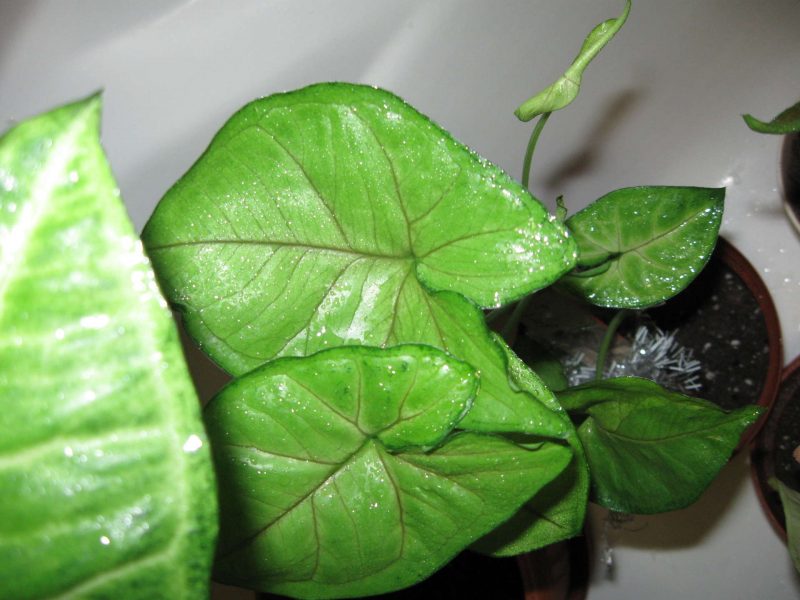
Liana does not like overflow and too bright sunlight. Water it only when the topsoil dries. Syngonium perceives well not only root dressings, but also leaf.
Features of the content depending on the season
In winter, the plant may suffer from a lack of light if it grows near windows facing north. A sign of poor lighting will be small, nondescript leaves and elongated shoots. Additional illumination will help to solve the problem.
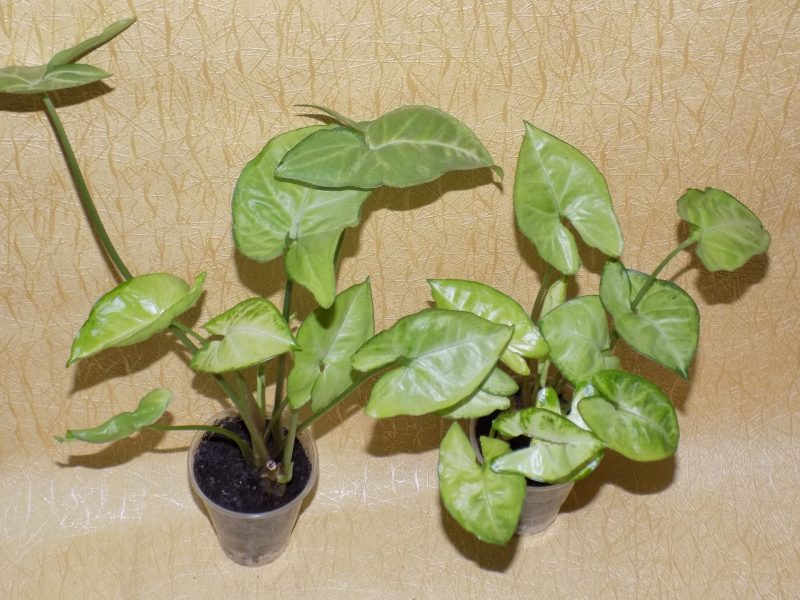
- The air temperature in the room in winter should be above 15 ° C.
- Syngonium does not like dry air, so during the heating season it is regularly sprayed with water, placed next to wet pebbles or moss.
- If there is a steam humidifier, then there are no problems with growing in winter.
In summer, the plant is watered when the soil dries 3 cm. With severe drying of the earthen coma, the leaves of the plant turn yellow and may fall. The heat-loving syngonium does not like drafts.
Watering syngonium
For irrigation use spring water or standing from the tap. If the water is too hard, it is better to pass it through the filter. In order for the roots to breathe, you need to wait until the top layer of the earth is completely dry, and only then water it abundantly, not forgetting to spray the foliage.

The roots of the plant should not be in the water, therefore, after watering, excess liquid is drained from the pan.
It is good to use melted snow or clean rain water for irrigation.
Soil Composition and Pot Selection
Land for planting syngonium should pass water and air well, be nutritious. A universal earthen mix from the store will do.
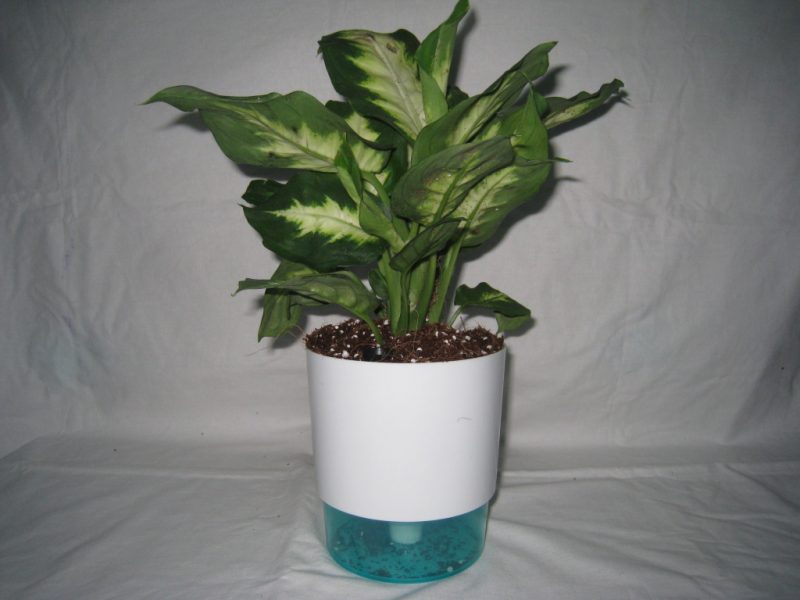
- A new pot is chosen a little larger in size than the one in which the plant lives.
- At the bottom there should be holes to drain excess water.
- The cultivation of syngonium is more successful in clay and chamotte pots, where the roots can "breathe".
When landing, a drainage layer is placed at the bottom of the tank, and then filled with earth. You can choose in the store a special primer for aroid ones with a slightly acidic or neutral reaction.
Fertilizer application
Syngonium must be fertilized once every 10-14 days. You can use liquid preparations on an organic basis or universal fertilizers for deciduous indoor crops, for example, "Magic Mix".
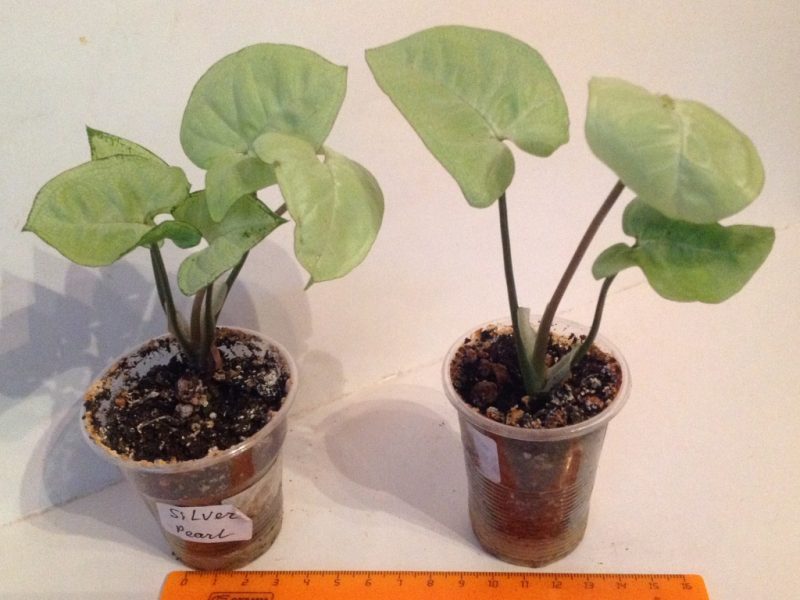
From April to September, the subcortex is held regularly. The plant does not like the high content of calcium in the soil, so they make sure that this element is not in the preparations for feeding.
In the autumn and winter, fertilizers are not needed.
Syngonium Trimming
The plant tolerates pruning well. The young seedling is pinched for the first time after the formation of three pairs of leaves, and to make the syngonium look more decorative, several seedlings are planted in one pot.

If the stem of an adult plant is exposed, it is pruned, stimulating the growth of new leaves and shoots. Also in spring it is necessary to cut off weak, low-quality shoots that spoil the decorativeness of the plant.
Landing and transplanting
After buying a creeper in a store, it is not immediately transplanted. The pot is put in a constant place so that the flower is used to new conditions.Only a month later, a new pot and nutritious soil are selected for the plant, in which it will successfully develop.

Young plants are preferably replanted annually. The soil is slightly acidic or neutral, you can prepare it yourself from equal parts of turf, leafy soil, sand and peat.
Syngonium is growing rapidly, so a transplant is done once every two years. They pick up a slightly larger pot and change the old earthen mixture to a fresh one in it.
The procedure for boarding and transplanting:
- Expanded clay is placed at the bottom of a new flower pot to provide good drainage.
- The plant is carefully pulled out together with an earthen lump from the old container.
- The earth is partially removed from the roots.
- Put the flower in a pot and fill it with freshly prepared soil.
- After planting, the ground is lightly pressed and watered with warm water.
If the plant will grow vertically up, before planting, a support is placed in the center of the pot. Then the seedling is moistened and placed in a warm, well-lit place. In the first month after planting or transplanting, the plant does not need fertilizers.
Propagation Features
Syngonium is propagated by cuttings or lateral processes in the warm season. You can put them in water or put in a light substrate for germination. To create a greenhouse environment, cuttings planted in a substrate are covered with a plastic bag.
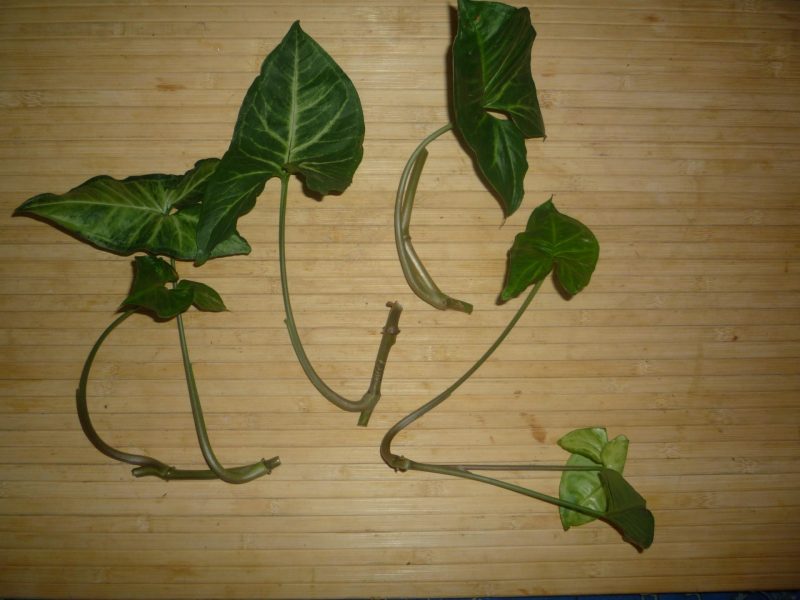
You can use vermiculite or a self-prepared substrate from equal parts of sphagnum and sand to root. Experienced growers are advised to add an activated carbon tablet to the water for the cuttings.
When the roots appear, plant a young bush in a small pot with good drainage and universal earthen mixture.
Plant diseases and pests
Syngonium is rarely affected by pests, but when you purchase an infected flower, harmful insects quickly move to all indoor plants.
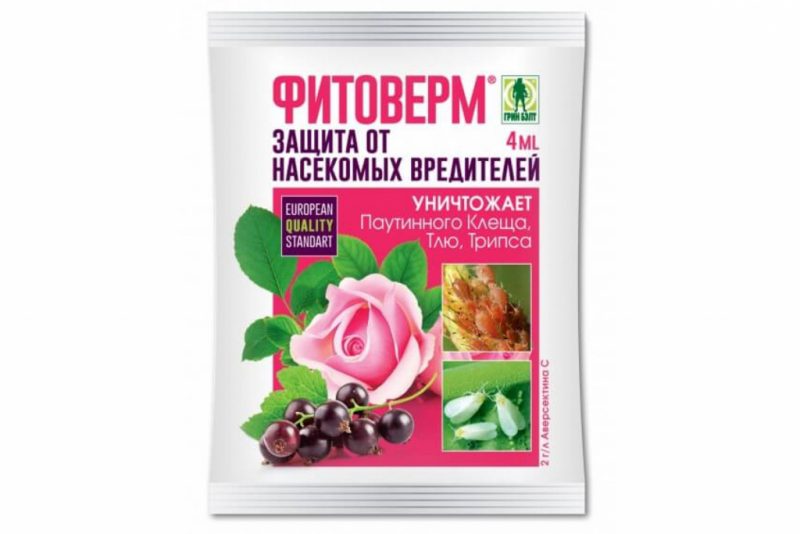
At the first signs of infection with a spider mite, scab, aphid or mealybug, spraying with an insecticide solution is necessary. For this purpose Fitoverm, Aktellik or Aktara is suitable.
When affected by fungal diseases (powdery mildew, late blight, gray rot), the plant is treated with a fungicide solution. It is advisable to transplant it into fresh soil, and cut off and destroy damaged leaves.
Why does syngonium wilt, leaves turn yellow?
Syngonium wilts and turns yellow when improperly maintained. Weakened plants die quickly if their living conditions are not changed.
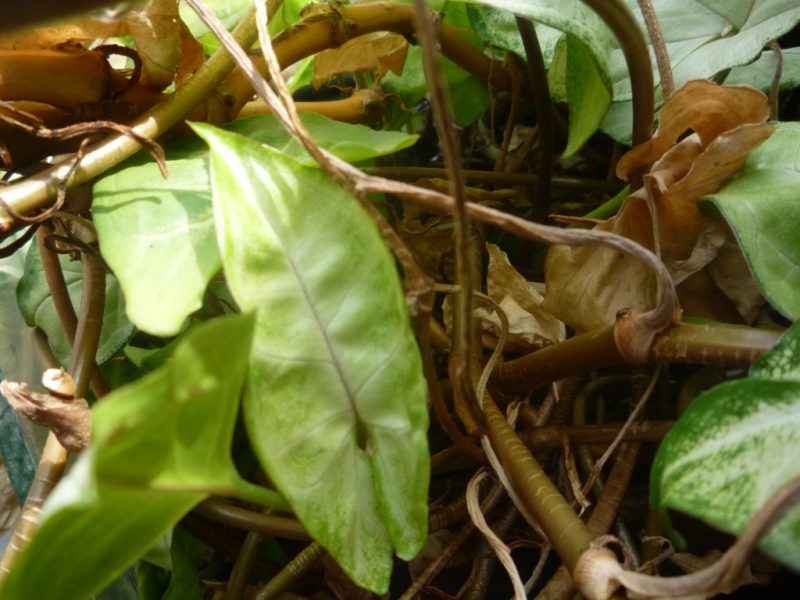
The cause of withering of the syngonium can be:
- dry indoor air;
- insufficient watering;
- poor pot drainage and stagnation of moisture at the roots;
- bright sun;
- low air temperature.
Lack of nutrients in the soil is also a common cause of leaf deformation and yellowing.
With proper care, the syngonium will give the owner right in the apartment a small piece of bright tropical jungle. He gratefully responds to the care with lush foliage and rapid growth.












